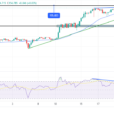The US dollar has fallen rather sharply over the past year or so, despite ongoing Fed rate hikes. This persistent dollar weakness has really boosted gold. There’s a fascinating interplay between these two currencies and futures speculators’ expectations for Fed rate hikes. These traders hang on every word from top Fed officials, which greatly influences their trading. So these relationships are important to understand.
In late December 2016, the venerable US Dollar Index surged to an incredible 14.0-year secular high. That was just a couple weeks after the Federal Reserve’s second interest-rate increase of this hiking cycle. Top Fed officials were forecasting three more rate hikes in 2017, fueling euphoric sentiment in this top reserve currency. Everyone believed higher prevailing interest rates would prove very bullish for the dollar.
Their logic was simple. The more the Fed raised its benchmark federal-funds rate, the more general rates would rise. That would boost the yields of dollar-denominated bonds led by US Treasuries. The higher yields went, the more attractive the dollar would look compared to other major currencies. Thus global investors would flock back to the US dollar as the Fed hiked, further extending the mighty dollar bull.
That very week I wrote an essay taking an unpopular contrary stance on the euphoric US dollar. In it I warned, “Traders are overwhelmingly betting the dollar’s strong upside will continue. But this greed-drenched currency looks very toppy and ready to fall, which is very bullish for gold.” That generated a lot of flak, but it’s usually the right decision to be bearish when everyone else is bullish near major secular highs.
Shocking traders, late 2016’s epically-overcrowded long-dollar trade indeed collapsed in 2017. That was despite the Fed actually carrying through on hiking three more times as expected. From that euphoric dollar peak in late December 2016 to the recent low, the USDX plunged 14.2% over 13.2 months! By world-reserve-currency standards that’s massive. This helped gold surge 18.1% higher over that same span.
Clearly the usual higher-rates-are-great-for-the-dollar arguments everyone believed in late 2016 weren’t correct. Nevertheless, futures speculators continue to trade based on that faulty premise almost every week. They rush to buy US-dollar futures and sell gold futures whenever something seems hawkish and implies more or faster Fed rate hikes. Once you start watching for this phenomenon, the examples seem endless.
The triggering catalysts are often comments from top Fed officials, official statements released after their policy-setting FOMC meetings, those meetings’ projections for future federal-funds-rate levels, and any major US economic data that surprises to the upside. Anything from these sources considered hawkish is used as an excuse to aggressively buy the dollar, which in turn convinces gold-futures speculators to sell.
These elite futures speculators still fervently believe higher yields driven by Fed rate hikes will boost the dollar. For many years now most sizable daily dollar rallies and gold selloffs have emerged from more-hawkish perceptions on Fed rate hikes. But while the basic logic sounds reasonable, this ever-popular thesis is torpedoed by market history. Futures speculators would do way better if they understood this.
This first chart takes a multi-decade view of that US Dollar Index and the Fed’s benchmark federal-funds rate. The FFR is actually a free-market interest rate the Fed can’t directly control. Banks are required to maintain reserves at the Fed, which they can borrow or lend overnight if they have temporary deficits or surpluses. This is the federal-funds market. The FOMC actually sets a target for the federal-funds rate.
For a decade now this target has been a quarter-point FFR range. The FOMC’s latest target from its late-January meeting is 1.25% to 1.50%. The Fed uses open-market operations to attempt to bully the actual FFR into its target range. This chart shows the midpoint of the Fed’s target range. It’s not only far less volatile than the real FFR, but the Fed rate hikes so enthralling futures speculators are target-range changes.

Because of the extreme leverage inherent in futures trading, speculators necessarily have an ultra-short-term time horizon. They can’t afford to be wrong for long at 25x or greater leverage. So these guys are often making trades they intend to hold for mere hours or days, maybe a couple weeks on the outside. They are so deep in the ultra-short-term weeds that they can’t see the forest for the trees on Fed rate hikes.
The Fed’s current rate-hike cycle, which is actually the 12th since the early 1970s, was born in December 2015. That initial hike was highly anticipated, as the Fed hadn’t boosted its FFR target for fully 9.5 years! The Fed began to prepare the markets for a new tightening cycle back in mid-2014. The FOMC started to talk hawkish after long years of its zero-interest-rate policy implemented during 2008’s extreme stock panic.












Leave A Comment